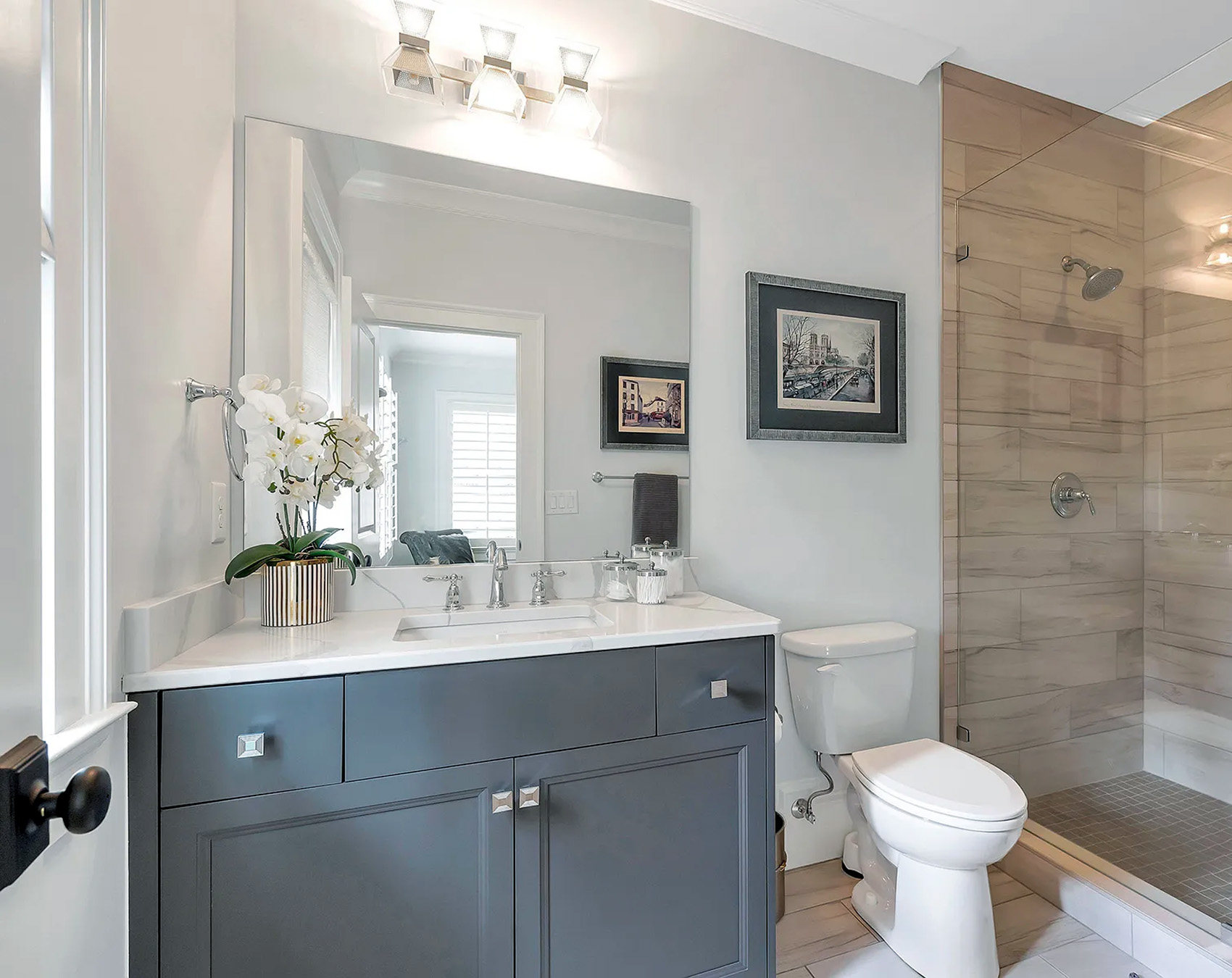How To Prevent Toilet Pipes From Freezing
As the temperature drops, many of us worry about our pipes freezing and bursting. This is especially true for toilet plumbing because it’s typically located on an exterior walls which get the coldest. However, it’s usually the water pipes leading to and from the toilet that freeze and not the tank or bowl. The best way way to prevent toilet pipes from freezing is insulation. Insulate your toilet water pipes really well, especially if they’re on an exterior wall. You can wrap the pipes with an insulated sleeve or use batt insulation or spray foam. Use as much insulation as possible between the pipes and the exterior wall.
If you can’t add insulation into the wall cavity, add it to the exterior wall instead. Foam panels or insulated siding are a great way to prevent frozen toilet pipes from the outside. They fasten to the exterior sheathing so no demo in the bathroom is required.
Turn up the heat in your home or heat your bathroom with a space heater when you’re away. Radiant heat inside the bathroom should be enough to keep the pipes above freezing.
If you’re leaving home for long periods of time during a cold Winter, winterize your toilets with some plumber’s antifreeze. Turn off the home’s water supply and flush your toilets, then pour a small amount of propylene glycol antifreeze into the tank and bowl. Antifreeze can resist temperatures of -36°F (-37.78°C) before it freezes, so pouring some into the toilet will keep it from freezing.
Just like any water pipe, a toilet can easily freeze if it gets cold enough. But you can prevent your pipes from freezing by increasing the heat in the bathroom, using antifreeze or installing adequate insulation in the correct areas. In this article I’ll explain how.
What Causes Frozen Toilet Pipes
Cold temperatures are the reason why toilet pipes freeze. Most toilet pipes are located on an exterior wall, which tends to get the coldest. If the pipes are not properly insulated, they’ll eventually freeze and the pipes will burst when the temperature rises. This can cause flooding inside the wall and major water damage to the home.
I do a lot of water remediation work, and the leading cause of frozen pipes of all kinds is inadequate or improperly installed insulation. Even if you have enough insulation inside the wall cavity, it still has to be installed properly.
- Pipes that are well insulated resit freezing.
- Insulation around pipes must be properly installed.
- Toilet pipes in exterior walls, attics, basements or crawl spaces with poor insulation are prone to freezing.
- Pipes in interior walls can freeze too if it gets cold enough.
Most, but not all, bathrooms are located on an exterior wall. Exterior walls generally get colder than interior walls because of wind. It’s important to insulate the pipes really well in order to prevent freezing pipes which can then burst.
If the exterior walls are well insulated, heat from the home will keep the pipes warm enough to prevent freezing. However, if the insulation is too thin, or improperly installed, the pipes could freeze.
To prevent freezing, make sure the pipes have a layer of insulation between the pipe and the outside wall. Position the pipes inside the wall cavity so that they’re closer to the inside wall than the outside wall. If you install the pipes too close to the exterior sheathing, you won’t have enough space to insulate them.
How To Identify Frozen Toilet Pipes
The best way to tell if your toilet pipes are frozen is if the water level in your bowl is unusually low or the toilet won’t fill up after a flush. This means the water supply pipe is frozen somewhere along the line from the main water supply to the toilet. Because of the freeze, fresh water can’t reach the toilet which prevents it from filling up.
- If the water inside the tank, bowl or trap is frozen, the toilet won’t flush and you’ll be able to see the ice inside the bowl and tank. This kind of toilet freeze is much easier to spot and fix.
- Frozen pipes often make a hissing or clanging noise when you turn on a faucet, so listen carefully.
- Another way to check if your pipes are frozen is to touch them. If they feel extremely cold or are covered in frost, they’re probably frozen solid.
If you suspect that your pipes are frozen, turn off the water supply and try to locate the problem area. Then apply heat to warm the pipe up and get water flowing again.
Once you unfreeze the pipe, turn on the water very slowly and look for leaks. If you find a leak, turn the water off again and call a plumber. If there are no leaks, go ahead and turn the water fully back on.
After you turn the water back on, keep the pipes warm to prevent them from freezing again, then address the cause of the freeze. In most cases, it’s an improperly insulated pipe, too little insulation, or a gap that’s letting cold air reach the pipe.
What To Do If Your Toilet Pipes Freeze
What to do if your toilet pipes freeze depends on where they’re located. Warming up exposed pipes in an attic, basement or crawl space is easier than if they’re hidden inside a wall cavity.
It’s important to unfreeze the pipes as quickly as possible to prevent them from bursting. Thing longer you let the pipes stay frozen, the higher the chance they’ll cause a burst pipes and leaks.
Here’s what to do:
- Warm exposed frozen pipes with a hair dryer, heating pad, heating cable, blanket, heat gun or space heater.
- Turn up your home’s thermostat to increase the temperature of pipes inside the walls.
- Use a space heater to warm up especially cold areas of the house.
- Pour hot water, not boiling, into the toilet while flushing several times. This can melt frozen water inside the toilet tank, bowl and trap, but it won’t unfreeze the pipes.
Once you unfreeze the pipes, look for reasons why they got so cold. The leading cause of frozen pipes is air penetration into the wall cavity, too little insulation around pipes or improper installation of insulation.
Keep the pipes warm to prevent them from freezing, then fix the cause by properly insulating the pipes.
How To Keep Toilet Pipes From Freezing
Frozen pipes can eventually burst when they heat up, which can cause flooding and major damage to a home. It’s crucial to prevent your pipes from freezing, especially if you’ll be away in Winter. Water inside a pipe freezes below 32°F, so all you have to do is keep your pipes above that temperature and they’ll be fine. Luckily, it’s fairly easy to do if you take certain steps in preparation for cold weather.
Ahead I’ll discuss what you can do to prevent your toilet pipes from freezing when temperature drop below freezing.
Insulate The Pipes
One of the most important things you can do to prevent frozen toilet pipes is adequately, and correctly, insulating them. I’ve been a builder for over 20 years, and the leading cause of house floods I see are burst pipes. The primary reason why pipes burst is too little or poorly installed insulation.
Insulation keeps heat inside the house and cold air out. To work properly, you need insulation installed between the pipes and the exterior cold. This means installing insulation behind the toilet pipes between the exterior sheathing and the pipe. If you install the pipes too close to the exterior wall, there won’t be enough room for insulation.
When you install toilet pipes, pull them as close to the interior wall as possible so you can stuff as much insulation behind them as possible.
In addition, you can also wrap water pipes on exterior walls with foam insulation. This helps prevent cold from penetrating into the pipe even more.
- Make sure there’s insulation between the pipe and exterior.
- Use foam pipe wraps in especially cold areas.
- Make sure there are no gaps where cold air could get into the wall cavity.
- Insulate pipes in wall cavities with batt or spray foam.
- Insulate your exposed toilet pipes in the attic, basement or crawl space with foam pipe wrap.
Make sure there are no gaps in your insulation which could let cold air in. Even if you use enough insulation R-value to protect the home, you also have to install it correctly. Seal all penetrations through the exterior siding and sheathing with expanding foam.
Remember, even a small gap in insulation that allows cold air into a wall cavity could freeze your pipes.
Heat The Bathroom
A great way to prevent toilet pipes from freezing is by heating the bathroom. Heating the entire home when you’re away can get expensive, but it may be necessary depending on the design of your home. In some cases you can simply heat the bathroom with a space heater to prevent leaks. But in some homes, especially multi-floor designs, the toilet pipes comes from far away, so heating just the bathroom won’t help much.
Higher temperatures inside the bathroom will warm the walls, which prevents the pipes from freezing. But if the pipes come from far away, they could still freeze in colder areas of the house. So more heat may be needed to prevent freezing.
- Heating the house when you’re away will prevent the pipes from freezing.
- Some homes can prevent frozen pipes simply by heating the bathroom, but this usually isn’t enough.
- Using a space heater to heat your bathroom will prevent the pipes around the toilet from freezing, but it won’t do anything for pipes outside the room.
Keeping your home above freezing in Winter will prevent the pipes from freezing. But it works best with adequate and properly installed insulation. In some rare cases, toilet pipes can freeze even in a heated house if cold air can penetrate into the wall cavities.
To prevent leaks, heat the home and make sure it’s well insulated. Seal all gaps through the siding and sheathing with expandable insulated foam. Make sure all your toilet pipes inside wall cavities are well insulated and wrap exposed water pipes in the attic, basement or crawl space with foam pipe wrap.
Keep Pipes Warm With Heating Cables
A great way to keep toilet pipes from freezing is by warming them with a heating cable. A warming cable plugs into a standard 110v outlet and runs along side the pipe. When turned on, it warms the pipe which prevents freezing. However, it only works on pipes that are accessible. This makes it a great solution for exposed water pipes in an attic, basement or crawl space, but a poor fix for pipes in a wall cavity.
If you have exposed pipes to worry about, consider using a heating cable to keep them warm. But heating cables are not a substitute for proper insulation. Think of them as an added layer of defense for areas where water pipes are most vulnerable.
- Heating cables can keep pipes from freezing by warming them up
- They plug into a standard 110v outlet.
- Heating cables work best on exposed pipes in an attic, basement or crawl space.
- Not the best choice for toilet pipes in a wall cavity.
Heating cables don’t work on pipes in a wall cavity unless you demo the wall. They’re best for exposed water pipes in an attic, basement or crawl space. But they’re not a substitute for insulation. Insulate the water pipes in wall cavities with batt or spray foam insulation and wrap exposed pipes with foam. Use spray foam to seal all gaps in the exterior sheathing and siding.
After properly insulating your home and wrapping exposed pipes, you can use heating cables as an additional defense against freezing in especially vulnerable areas like an attic, basement or crawl space.
How To Prevent A Toilet From Freezing
One of the best ways to prevent your toilet from freezing during a cold Winter is by winterizing it with a plumber’s antifreeze called propylene glycol. Do not use ethylene glycol, which is the antifreeze used in cars. It’s toxic and can damage your pipes and toilet. Water freezes at 32°F, but antifreeze doesn’t freeze until it reaches -36°F. That’s a 68°F difference, which is enough to prevent your toilet from freezing.
Keep in mind this process protects the toilet tank, bowl and trap from freezing, but not the pipes.
Here’s how to do it:
- Turn off the home’s main water supply valve.
- Turn off the gas valve on the water heater or the breaker if you have an electric water heater.
- Drain the water heater tank.
- Open all indoor faucets, both hot and cold sides. This includes sinks, showers, and bathtubs.
- Unhook your washing machine hoses and open the valves.
- If you have water filters or a water softener they’ll need to be drained.
- Flush all the toilets to drain most of the water out of the tanks. They won’t refill because the water supply is off.
- Pour some propylene glycol into the toilet tanks
- Pour about a pint of antifreeze into each toilet bowl.
- Pour propylene glycol into every drain trap throughout the home. These include sinks, tubs, showers, and the washing machine discharge pipe.
Doing this will fill the toilet with enough antifreeze to prevent water in the toilet tank, bowl, and trap from freezing. Without winterizing, water in your toilet could freeze and crack the porcelain and/or trap.
Remember to flush the toilets before using them again after Winter. This will remove all the antifreeze stored in the bowl and tank.
Can You Flush A Toilet If The Pipes Are Frozen?
If the toilet water supply line is frozen, you can flush the toilet once, but it won’t fill up with water afterwards. This is one of the ways you can tell that your toilet pipes have frozen. To flush the toilet a second time, you’ll have to fix the freeze or fill the tank up manually with water.
If water in the toilet trap pipe is frozen, you won’t be able to flush the toilet. But in this case water in the tank and bowl will also be frozen so the toilet will be unusable.
- If the toilet’s supply line pipe is frozen, you can flush the toilet once but it won’t fill with water again.
- To flush it again, you need to unfreeze the pipe or manually fill the toilet tank.
- If water in the toilet bowl, tank or trap is frozen, the toilet won’t flush.
If you have a bidet toilet combo and the bidet water line freezes but the water supply line doesn’t, the toilet will work normally and will continue to fill and flush.
How Do You Prevent Toilet Pipes from Freezing?
The best way to prevent toilet pipes from freezing is insulation. Make sure you properly insulate any exterior wall cavity that has plumbing. Always use the correct amount of R-value as required by code and make sure to properly install the insulation. Just because you use the right type of insulation doesn’t mean the pipe is protected.
There needs to be insulation between the pipe and exterior wall. When installing water pipes, position them as close to the interior heated space as possible. This allows room behind the pipe, between the pipe and cold exterior, for insulation.
If you position the pipe to close to the exterior wall, there may not be enough room for adequate insulation.
Here are some other tips you can use to keep toilet pipes from freezing:
- Seal gaps in the exterior siding and sheathing with foam to prevent drafts.
- Wrap exposed pipes in an attic, basement or crawl space with foam insulation to help prevent freezing.
- Heat exposed water supply pipes with electric heating cables.
- Winterize your toilet with a plumber’s antifreeze to prevent the bowl, tank and trap from freezing.
- Use a space heater in especially cold areas of the house.
- Keep the home heated in Winter even when you’re away.
- Drain the water lines by turning off the main water supply and running all the faucets and flushing all the toilets.
- Consider keeping your home heated even when you’re away.
The leading cause of flooded homes are burst pipes. But luckily, they’re fairly easy to prevent if you take the time to properly insulate your exterior walls and exposed pipes. Seal all exterior gaps in your siding where cold air can reach the pipes with foam and wrap exposed piping with foam insulation.
Summary: How To Prevent Toilet Pipes From Freezing
As the temperature drops, many of us worry about our pipes freezing and bursting. This is especially true for toilet plumbing because it’s typically located on an exterior walls which get the coldest. However, it’s usually the water pipes leading to and from the toilet that freeze and not the tank or bowl. The best way way to prevent toilet pipes from freezing is insulation. Insulate your toilet water pipes really well, especially if they’re on an exterior wall. You can wrap the pipes with an insulated sleeve or use batt insulation or spray foam. Use as much insulation as possible between the pipes and the exterior wall.
- If you can’t add insulation into the wall cavity, add it to the exterior wall instead.
- Foam panels or insulated siding are a great way to prevent frozen toilet pipes from the outside. They fasten to the exterior sheathing so no demo in the bathroom is needed.
- Turn up the heat in your bathroom with a space heater when you’re away.
- Radiant heat inside the bathroom should be enough to keep the pipes above freezing.
- If you’re leaving home for long periods of time during Winter, winterize your toilets with some plumber’s antifreeze.
- Turn the home’s water off and flush your toilets > pour a small amount of propylene glycol antifreeze into the tank and each bowl to prevent freezing.
- Antifreeze can resist temperatures of -36°F (-37.78°C) before it freezes.
Just like any water pipe, a toilet can easily freeze if it gets cold enough. But you can prevent your pipes from freezing by increasing the heat in the bathroom, using antifreeze or installing adequate insulation in the correct areas.
If you have any questions or comments about how to prevent toilet pipes from freezing, email any time.























